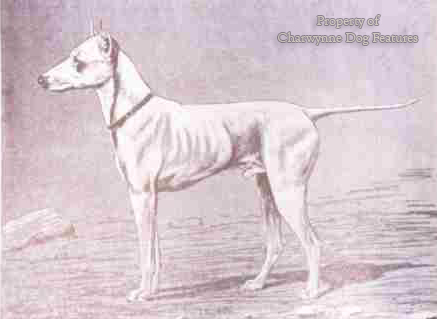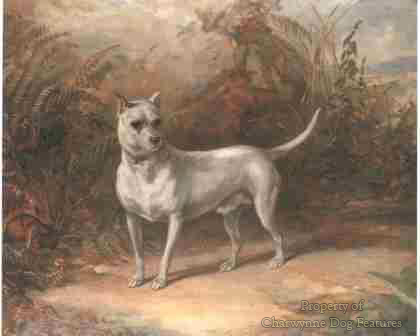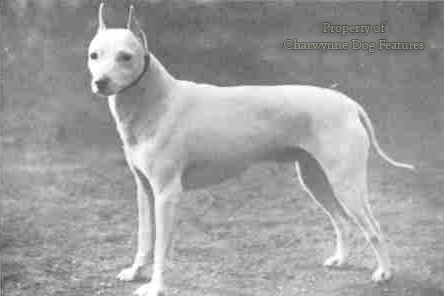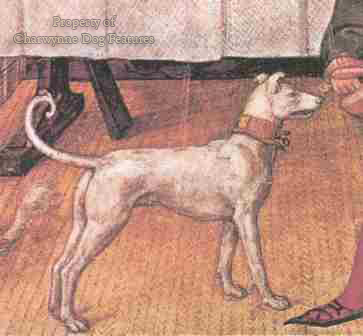198 National English Terrier
WHY NO ENGLISH NATIONAL TERRIER?
by David Hancock
 For a country which has produced more breeds of terrier than any other and for a country in a group of islands which did more than any other to establish terriers as a canine type, it is quite extraordinary that England does not have a national terrier, as such, by name. The Welsh, the Irish and the Scottish terriers have each long been recognised as such, but never used unlike the bulldog as national symbols. Claims have been made, I know, for the Manchester terrier to be the terrier of England. Some, I am aware, claim that the Welsh hi-jacked the old broken-coated black and tan terrier of the British mainland and made that type their own. Toydog owners can point to the English Toy terrier, but purists might see this tiny breed as a toy Manchester and better named as such. But for the Australians, the Germans, the Czechs and now the Japanese and the Brazilians to have a national terrier and not the English is an absurd and surely unacceptable situation. Even the Tibetans have one -- at least by name! As did the Maltese, for a while. There may well be more so-called Jack Russells gracing (or disgracing!) the terrier scene of England than any other breed type. But as yet no one has tried to give it a national tag even though hound-marked terriers have featured in many parts of England (and Wales) for at least a century. Yet we did once have an English terrier, not a toy, by name : the English white terrier. White bull terrier fanciers may claim that the blood of the English white lives on in their breed. But the English white terrier was once so well known and bred
For a country which has produced more breeds of terrier than any other and for a country in a group of islands which did more than any other to establish terriers as a canine type, it is quite extraordinary that England does not have a national terrier, as such, by name. The Welsh, the Irish and the Scottish terriers have each long been recognised as such, but never used unlike the bulldog as national symbols. Claims have been made, I know, for the Manchester terrier to be the terrier of England. Some, I am aware, claim that the Welsh hi-jacked the old broken-coated black and tan terrier of the British mainland and made that type their own. Toydog owners can point to the English Toy terrier, but purists might see this tiny breed as a toy Manchester and better named as such. But for the Australians, the Germans, the Czechs and now the Japanese and the Brazilians to have a national terrier and not the English is an absurd and surely unacceptable situation. Even the Tibetans have one -- at least by name! As did the Maltese, for a while. There may well be more so-called Jack Russells gracing (or disgracing!) the terrier scene of England than any other breed type. But as yet no one has tried to give it a national tag even though hound-marked terriers have featured in many parts of England (and Wales) for at least a century. Yet we did once have an English terrier, not a toy, by name : the English white terrier. White bull terrier fanciers may claim that the blood of the English white lives on in their breed. But the English white terrier was once so well known and bred so true to type that a renaissance would be justified and an absurd gap in the list of terrier breeds thereby filled. Breeders of all-white dogs know of the problems of pigmentation, deafness and even sterility associated with this colour, but skilful dog breeders, determined to breed out such faults, will normally triumph as so many all-white breeds demonstrate today. In his book "All about the Bull Terrier", the late Tom Horner wrote that: "When Hinks set out to breed a strain of whites (i.e. bull terriers) he was perhaps inspired by the White English terrier, which at that time had attained a far higher standard and had much more grace of form and quality than anything he could find among the old style Bull-and-Terrier." How pleasing it would be to have that "grace of form" once more in a breed of dog restored to us. Writing in his "Terriers" of 1922, Darley Matheson recorded: "The writer would like to see really serious attempts made to revive the English white terrier, because it is a type, or rather variety, of dog which makes an excellent companion..." I agree and was interested to read of his recommended blend to resurrect the breed: a cloddy type of bull terrier bitch to a whippet dog, with a further outcross to the Manchester terrier. He envisaged a 15 to 18lb dog and outlined a rough likely breed standard. He favoured a fox terrier ear for such a recreated breed, knowing full well that the ban on cropping, together with sterility, led to the demise of the original breed. But what did the original breed actually look like?
so true to type that a renaissance would be justified and an absurd gap in the list of terrier breeds thereby filled. Breeders of all-white dogs know of the problems of pigmentation, deafness and even sterility associated with this colour, but skilful dog breeders, determined to breed out such faults, will normally triumph as so many all-white breeds demonstrate today. In his book "All about the Bull Terrier", the late Tom Horner wrote that: "When Hinks set out to breed a strain of whites (i.e. bull terriers) he was perhaps inspired by the White English terrier, which at that time had attained a far higher standard and had much more grace of form and quality than anything he could find among the old style Bull-and-Terrier." How pleasing it would be to have that "grace of form" once more in a breed of dog restored to us. Writing in his "Terriers" of 1922, Darley Matheson recorded: "The writer would like to see really serious attempts made to revive the English white terrier, because it is a type, or rather variety, of dog which makes an excellent companion..." I agree and was interested to read of his recommended blend to resurrect the breed: a cloddy type of bull terrier bitch to a whippet dog, with a further outcross to the Manchester terrier. He envisaged a 15 to 18lb dog and outlined a rough likely breed standard. He favoured a fox terrier ear for such a recreated breed, knowing full well that the ban on cropping, together with sterility, led to the demise of the original breed. But what did the original breed actually look like? What is the evidence from photographs and paintings? Dealing with the latter first; one of the difficulties of researching such a breed is that sporting dogs, favoured by the nobility, such as pointers, setters, spaniels, hounds of the chase and especially coursing dogs have been portrayed exhaustively (if often inaccurately) down the centuries. Dogs of the working classes, however, such as sheepdogs and ratting terriers, have been seriously neglected. But if you look at English naive painting from say 1750 to 1900 and in particular the work of artists such as Clark, Sturr, Whitehead, Balls and Roebuck, you begin to get a much better appreciation of the street dogs of their time. Scholars and art historians are verbose on the subject of classical art and mainly silent on the subject of folk art or naive painting. Seventeenth century Flemish painters are fawned over, but ordinary English people had their art too. For a dog historian or breed researcher, naive art is a largely untapped source. Look at Thomas Roebuck's "Crib" of 1860, "The Royal Rat Catcher" by J.Clark even earlier and the work of unknown artists of the same period, such as "Bear Baiting" and "The West Bromwich Sweep". There you see the all white terrier very valuably depicted. If, however, the distinctive appearance of the white terrier type of dog is pursued in even earlier portrayals then the painting in St. Mark's Library in Venice, entitled 'The Grimani Breviary' of 1515,
What is the evidence from photographs and paintings? Dealing with the latter first; one of the difficulties of researching such a breed is that sporting dogs, favoured by the nobility, such as pointers, setters, spaniels, hounds of the chase and especially coursing dogs have been portrayed exhaustively (if often inaccurately) down the centuries. Dogs of the working classes, however, such as sheepdogs and ratting terriers, have been seriously neglected. But if you look at English naive painting from say 1750 to 1900 and in particular the work of artists such as Clark, Sturr, Whitehead, Balls and Roebuck, you begin to get a much better appreciation of the street dogs of their time. Scholars and art historians are verbose on the subject of classical art and mainly silent on the subject of folk art or naive painting. Seventeenth century Flemish painters are fawned over, but ordinary English people had their art too. For a dog historian or breed researcher, naive art is a largely untapped source. Look at Thomas Roebuck's "Crib" of 1860, "The Royal Rat Catcher" by J.Clark even earlier and the work of unknown artists of the same period, such as "Bear Baiting" and "The West Bromwich Sweep". There you see the all white terrier very valuably depicted. If, however, the distinctive appearance of the white terrier type of dog is pursued in even earlier portrayals then the painting in St. Mark's Library in Venice, entitled 'The Grimani Breviary' of 1515,  shows this type quite clearly. Of course before the days of pedigree dog breeding, white houndlike and white terrier-type dogs abounded, but this particular portrayal is of significance. It shows a distinct type rather than just a passing resemblance to an emerging breed of those times. Today we lack not only a genuine terrier with English in its name but this time-honoured type of dog too. Victorian and Edwardian writers such as Hugh Dalziel and Robert Leighton had firm views on the English White. Vero Shaw complained about the introduction of Italian greyhound blood, leading to a loss of terrier characteristics. He quotes Mr. James Roocroft of Bolton, a prominent breeder of English Whites, as making adverse comments about some specimens showing "in a marked manner a cross of the snap-dog breed". He described the breed as 18" at the shoulder and weighing 19lbs. W.D.Drury, in his "British Dogs" of 1903, states that: "The White English Terrier has undergone considerable modification since public dog shows came into being." He also commented on a loss of terrier character in the breed. But he writes admiringly of the breed: "A good specimen of the White English Terrier is quite an aristocrat amongst Terriers -- a high class, superior type of dog, fit company for anyone." Dalziel, in his "British Dogs" of 1888, shows where Drury obtained the first of the above quotes from -- verbatim! (Such blatant copying is so dangerous when the facts are wrong, lazy researchers see repetition as corroboration). Dalziel disliked "the wheel back and hooped tail, inherited from no very remote ancestor, are very
shows this type quite clearly. Of course before the days of pedigree dog breeding, white houndlike and white terrier-type dogs abounded, but this particular portrayal is of significance. It shows a distinct type rather than just a passing resemblance to an emerging breed of those times. Today we lack not only a genuine terrier with English in its name but this time-honoured type of dog too. Victorian and Edwardian writers such as Hugh Dalziel and Robert Leighton had firm views on the English White. Vero Shaw complained about the introduction of Italian greyhound blood, leading to a loss of terrier characteristics. He quotes Mr. James Roocroft of Bolton, a prominent breeder of English Whites, as making adverse comments about some specimens showing "in a marked manner a cross of the snap-dog breed". He described the breed as 18" at the shoulder and weighing 19lbs. W.D.Drury, in his "British Dogs" of 1903, states that: "The White English Terrier has undergone considerable modification since public dog shows came into being." He also commented on a loss of terrier character in the breed. But he writes admiringly of the breed: "A good specimen of the White English Terrier is quite an aristocrat amongst Terriers -- a high class, superior type of dog, fit company for anyone." Dalziel, in his "British Dogs" of 1888, shows where Drury obtained the first of the above quotes from -- verbatim! (Such blatant copying is so dangerous when the facts are wrong, lazy researchers see repetition as corroboration). Dalziel disliked "the wheel back and hooped tail, inherited from no very remote ancestor, are very  objectionable, and are generally accompanied by a soft 'unvarminty' look". Just over thirty years later, Robert Leighton was recording that he had not discovered a single specimen of the true type in the last ten years (i.e.1912-1922). But he went on to write in his "The Complete Book of the Dog" that: "It is apparent that the Whippet was largely used as a cross with the English terrier, which may account to a great extent for the decline of terrier character in the breed. Wiser breeders had recourse to the more closely allied Bull-terrier.." Leightonstates that "Mr. Shirley's prize-winning Purity was by Tim out of a Bull-terrier bitch"; a founder-member of the Kennel Club winning with a cross-bred dog -- there's a sign of the times! Ash describes the first white terrier as appearing in an illustrationin the illuminated manuscript depicting the Ordinance of Charles theBold of 1473. But Rawdon Lee, strong on the breed histories during his lifetime but
objectionable, and are generally accompanied by a soft 'unvarminty' look". Just over thirty years later, Robert Leighton was recording that he had not discovered a single specimen of the true type in the last ten years (i.e.1912-1922). But he went on to write in his "The Complete Book of the Dog" that: "It is apparent that the Whippet was largely used as a cross with the English terrier, which may account to a great extent for the decline of terrier character in the breed. Wiser breeders had recourse to the more closely allied Bull-terrier.." Leightonstates that "Mr. Shirley's prize-winning Purity was by Tim out of a Bull-terrier bitch"; a founder-member of the Kennel Club winning with a cross-bred dog -- there's a sign of the times! Ash describes the first white terrier as appearing in an illustrationin the illuminated manuscript depicting the Ordinance of Charles theBold of 1473. But Rawdon Lee, strong on the breed histories during his lifetime but  weak on ancestry, describes the English White as a modern breed. I suspect that the English White terrier was until the late 19th century, a distinct breed-type favoured by the working classes, especially by sweeps, pugilists and rat-catchers. The advent of dog shows brought about the pursuit of a daintier lookingdog and this tendency, allied to the ban on ear-cropping, led to the disappearance of the breed. A sad loss. For many members of the public, a medium-sized, short-coated dog, without the instinct to hunt game or herd sheep, yet which is a lively companion without demanding huge amounts of exercise, would make an ideal house pet. If the English White terrier could be re-created, then bred true, be of stable temperament and free of the many inheritable defects currently plaguing so many pedigree breeds, then the British public would surely respond. The Russians have created the Russian terrier as a scientific project. We ourselves certainly have the genetic material and the breeding expertise to restore a national terrier to our currently incomplete, however distinguished, list of native terrier breeds. What a challenge for a skilled breeder! And what an accomplishment for a bunch of patriotic dog fanciers wishing to leave something worthwhile behind them as their life's work. I can't think that they would be out of pocket either in these days of resurgent nationalism. The terrier is very British; the Welsh, the Scots and the Irish have their own national terrier by name, where's the English terrier to complete the full house? Come on terrier-loving patriots, before we have a Euro-terrier thrust upon us, get to work! What a gentle but effective way to demonstrate national pride!
weak on ancestry, describes the English White as a modern breed. I suspect that the English White terrier was until the late 19th century, a distinct breed-type favoured by the working classes, especially by sweeps, pugilists and rat-catchers. The advent of dog shows brought about the pursuit of a daintier lookingdog and this tendency, allied to the ban on ear-cropping, led to the disappearance of the breed. A sad loss. For many members of the public, a medium-sized, short-coated dog, without the instinct to hunt game or herd sheep, yet which is a lively companion without demanding huge amounts of exercise, would make an ideal house pet. If the English White terrier could be re-created, then bred true, be of stable temperament and free of the many inheritable defects currently plaguing so many pedigree breeds, then the British public would surely respond. The Russians have created the Russian terrier as a scientific project. We ourselves certainly have the genetic material and the breeding expertise to restore a national terrier to our currently incomplete, however distinguished, list of native terrier breeds. What a challenge for a skilled breeder! And what an accomplishment for a bunch of patriotic dog fanciers wishing to leave something worthwhile behind them as their life's work. I can't think that they would be out of pocket either in these days of resurgent nationalism. The terrier is very British; the Welsh, the Scots and the Irish have their own national terrier by name, where's the English terrier to complete the full house? Come on terrier-loving patriots, before we have a Euro-terrier thrust upon us, get to work! What a gentle but effective way to demonstrate national pride!